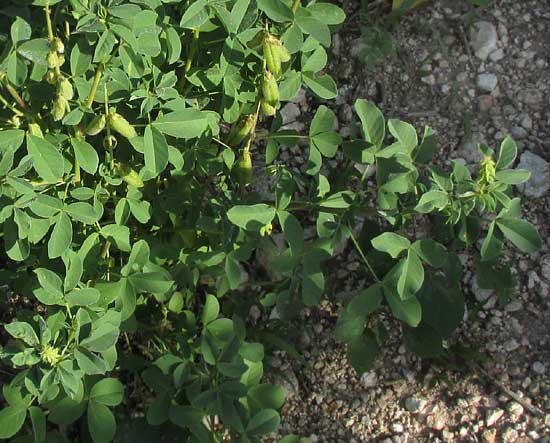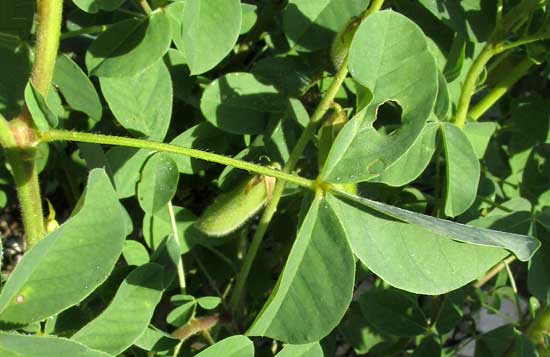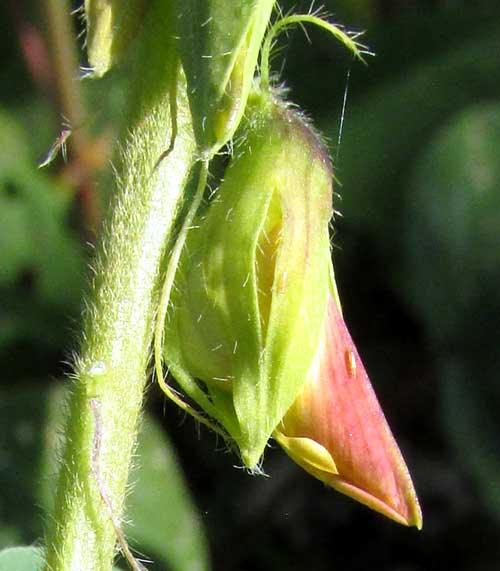Excerpts from Jim Conrad's
Naturalist Newsletter
from the July 17, 2016 Newsletter issued from Hacienda Chichen Resort beside Chichén Itzá Ruins; limestone bedrock; elevation ~39m (~128ft), N20.675°, W88.569°; central Yucatán state, MÉXICO
SHAKESHAKE
Along a backcountry gravel road a much-branching bush about as broad as a semi-truck wheel bore trifoliate, clover-like leaves and green, pea-type pods, as shown below:

Even from a distance the leaves and legume-type fruits made clear that we had a member of the Bean Family. Moreover, the inflated legumes were of a type so unusual that I figured I knew which genus the plant belonged to. But, before I could be sure about it, I needed to look closer at one of its three-parted, compound leaves, which really did look like a big clover leaf, shown below:

A close-up of the hairy, dew-wet legumes, very similar to pea pods -- and peas are members of the Bean Family -- is shown below:

The bush was issuing new sprouts bearing immature flowers. Though the blossoms were not yet expanded, they showed details serving as important field marks for the species, seen below:

Normally this genus -- which I assumed to be Crotalaria, famous for its inflated pods -- produces yellow flowers, but when the blossoms are immature they may be flushed with pinkness, like this one. In the picture, important field marks helping identify this to species level are the hairiness and the calyx, and its being so deeply divided that its sepals are long and slender.
This is CROTALARIA INCANA, in English literature often named Shakeshake, because when you shake their mature, dry pods, they rattle. In Spanish it's called "Cascabelillo," meaning "Little Bell." As a group, species of the genus Crotalaria often are called rattlepods or rattleboxes, so the rattling pods is definitely something people notice, especially in rattlesnake country.
The genus Crotalaria is a big one embracing about 500 species of herbs and shrubs, mostly in Africa (400 species) but with a fair number here in the Americas, both tropical and temperate. Our Crotalaria incana is so widely distributed that it's unclear where it originated, being either native or invasive throughout the world, except for the colder parts. In the US it's introduced into all the lower 48 states, plus Hawaii, favoring dry forests and disturbed areas.
In Mexico it's known as a weed in fields of corn and sorghum, and in orchards. Its rattling seeds are supposed to contain alkaloids that can be toxic to animals.
Often toxic plants are used in precise dosages as medicinal herbs, and that's the case here. The online Biblioteca Digital de la Medicina Tradicional Mexicana reports that in Mexico the main medicinal use is to keep children from bed wetting. The seeds are cooked, apparently detoxifying the alkaloids, mashed, and fed to the children, or else a tea is brewed of the mature branches and drunk at night. Sometimes the seeds are swallowed directly, and leaves serve as ingredients in prepared food. These treatments are used for other urinary problems as well, and such unrelated ailments as diabetes, inflamed gums and snakebike.